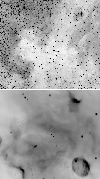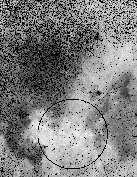 |
Figure 2:
2MASS color-magnitude diagram of all the stars brighter than
|
| Open with DEXTER | |
In the text
 |
Figure 3:
Infrared spectra of carbon stars included in our sample,
characterized by the sharp flux drop at
|
| Open with DEXTER | |
In the text
 |
Figure 4:
Infrared spectra of mid- or late-type objects included in our
sample other than carbon stars, characterized by the appearance of CO bandheads
longwards of 2.29 |
| Open with DEXTER | |
In the text
 |
Figure 5:
Two stars with early-type spectra ruled out as possible ionizing
sources. Star #9 is an unobscured star classified in the visible as F5V, while
the prominent Br |
| Open with DEXTER | |
In the text
 |
Figure 6:
Spectrum of Star #11, showing the Balmer lines H |
| Open with DEXTER | |
In the text
 |
Figure 7:
Infrared spectrum of Star #4 = J205551.3+435225, which we propose
as the ionizing star for the North America and Pelican nebulae. The lack of
absorption lines at the resolution of this spectrum is consistent with a O or
early B type, or with a F or later type. The former possibility is favored by
the
|
| Open with DEXTER | |
In the text
 |
Figure 8:
Visible spectrum of Star #4 = J205551.3+435225. Note the
appearance of a strong HeII line at
|
| Open with DEXTER | |
In the text
 |
Figure 9:
A detailed visible view of the L935 dark cloud separating the
North America and the Pelican nebulae, marking the position of
Star #4 = J205551.3+435225. The upper panel shows a
|
| Open with DEXTER | |
In the text
 |
Figure 1:
The region of the North America (NGC 7000) and the Pelican
(IC 5070) nebulae with the |
| Open with DEXTER | |
In the text